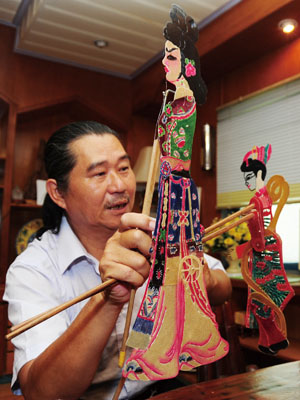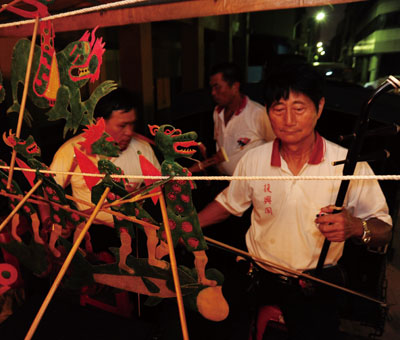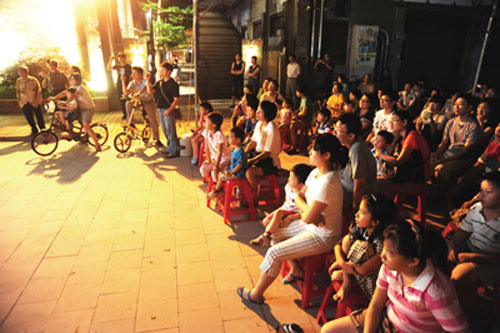The Traditional Performance Art of Shadow Puppetry / 玩光弄影 皮影戲
The Traditional Performance Art of Shadow Puppetry
 ◎English Translation: Peng Hsin-yi
◎English Translation: Peng Hsin-yi
◎Photos by Pao Chung-hui
The traditional performance art of shadow puppetry can be dated back to the Han dynasty. It is an art form that remains relatively unchanged, with performances that combine singing, puppetry and leather sculpture. Shadow puppet troupes were more customary and highly revered in the 1950s and 60s. At that time it was the most accessible form of public entertainment, with temples using them in ceremonies to honor the gods. Performances would begin with puppeteers placing their leather puppets against a silkscreen and with the snap of the lights, the elegant puppet silhouettes would burst into song.
Today, one of the most reputable troupes in Kaohsiung is Mituo district's fifty-year-old, award-winning, Fu Hsing Ko Shadow Puppet Troupe. Mr. Syu Fujhu (the troupe's current chief puppeteer) describes many intricate details of puppeteer training.Puppeteers must undergo an extensive and arduous training process which begins with mimicking tapes of past master's voices and tones. Even before they are allowed to work as an assistant, they must learn all the songs. They must also learn the complicated carving techniques. Puppets typically take four days to construct. A strict hierarchy is adhered and even the most talented apprentices must start out as an assistant to the lead puppeteer. Training includes practicing the lines, songs and accumulating hands-on experience.
In shadow puppetry there are generally two genres. Dramas performed with songs and poetry are hard to memorize and less popular. Today, audiences prefer the second genre, which features more stunts and demands puppeteers' skills. A senior puppeteer would capture an audience with heartfelt, emotional songs and masterful control of the puppet. Past performances needed at least five people to put on the show, a lead puppeteer, an assistant, the light technician and musicians. Today Fu Hsing Ko's productions need nine people and are much more complex and ambitious. They have also transcended language and cultural barriers and have performed several times in the U.S. and major European cities.
Formed in 2002 by the current manager and former apprentice in Fu Hsing Ko, Mr. Chen, Horng Shinq Ger Silhouette Show is a newer, well-known troupe in Kaohsiung. Mr. Chen is a life long puppet fan and wanted to bring about a new vision for the traditional art form. Mr. Chen is an expert in animal mimicry and masterful puppeteer. His puppetry uses puppets as large as a small child and utilizes as many as seven control rods with ten people manipulating them. Mr. Chen wanted to reach out to a younger generation and adopted several new performance styles, which include putting puppeteers and puppets in front of the screen. This also enriched the visual effects and created a new dynamic in the art of lighting and shadows. Mr. Chen has adopted puppet making techniques from China, including more vibrant colors which give greater contrast and depth to the puppets. He also revolutionized the puppets' joints, making it easier to perform swift stunts and creating a three dimensional visual effect.
Today, puppeteers are adamant about preserving this traditional art form. Some have revolutionized it by incorporating more modern elements. Kaohsiung is proud of its shadow puppeteers' dedication and passion for the traditional folk art. Each performance pays homage to its rich heritage and tradition. Even today theaters continue to fill up and the art form maintains its traditional glory.
 玩光弄影 皮影戲
玩光弄影 皮影戲
◎文/張嘉玲 ◎攝影/鮑忠暉
乘著夜色,拉把椅凳坐在棚下,燈光打下,曲線優美的人物剪影翩翩出現在前方螢幕上,躲藏螢幕後方的皮影戲演師(主演)拉開嗓門,角色模仿絲絲入扣。這樣的場景在民國四、五○年代相當常見,迎神廟會的場合更少不了皮影戲。
高雄彌陀的皮影劇團「復興閣」演出已逾50年歷史,國內獲獎無數。學徒為學會皮影戲的唱腔曲調,靠著反覆聆聽錄音帶,將師祖代傳下的曲調熟記於心 ,才能上場演出。再來,要學雕刻,以刻刀在厚實牛皮上刻出人物側面剪影,現任團主許福助說,平均四天才能刻出一尊精緻的影偶。即使資質好的學徒,也需由助理演員開始擔任,與主演練習台詞對答,實地演出多年後才有機會升上主演。許福助表示,早期演出約需5 位人手,除了主演、助理演員外,還有燈光師與樂師等。而今復興閣演出,因劇情增添許多角色,需靠9個人分工合作。皮影戲的文戲演出以歌謠為主,難以記憶,現今文戲已罕見演出,多為熱鬧的武戲,因此操控影偶的技巧更形重要。許福助說,復興閣維持傳統潮州唱腔,老經驗的皮影戲演師唱詞富有情感 ,靠著雙手靈活操縱影偶,令觀眾讚賞不已,屢屢遠赴美國、歐洲等地演出。
民國91年始於高雄創立的宏興閣,團主陳政宏從小就是偶戲迷,曾在復興閣學藝的他表示,為吸引年輕觀眾,他嘗試創新,宏興閣的影偶演出時不再侷限於螢幕內,偶師直接站在影偶的兩旁進行操作,配合打光產生的光影變化,讓視覺效果更顯豐富。陳政宏表示,他參考大陸影偶,讓影偶配色更為鮮豔,具有深淺變化,並改良影偶的關節處,利用操縱技巧,影偶可以俐落轉身,皮影戲由平面變得有立體感,模仿起動物動作栩栩如生。一尊大型影偶幾與孩童同高,最多需使用7根操縱桿控制,往往要有十幾個人手同台演出。
這門傳統民間娛樂活動包含了唱腔、演出、雕刻等技藝,自漢朝起已深受肯定。無論對傳統的堅持或是另闢蹊徑,高雄在地皮影戲團都以無限熱情與堅持 ,演繹場場傳奇,重現昔日舞台前坐無虛席的盛景。藝術即生活,在這裡不露痕跡地體現。